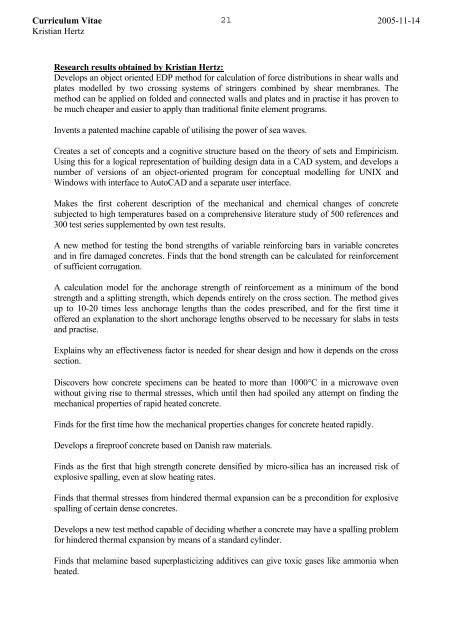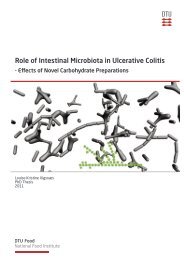Curriculum Vitae for Kristian Hertz - Danmarks Tekniske Universitet
Curriculum Vitae for Kristian Hertz - Danmarks Tekniske Universitet
Curriculum Vitae for Kristian Hertz - Danmarks Tekniske Universitet
You also want an ePaper? Increase the reach of your titles
YUMPU automatically turns print PDFs into web optimized ePapers that Google loves.
<strong>Curriculum</strong> <strong>Vitae</strong><br />
<strong>Kristian</strong> <strong>Hertz</strong><br />
21<br />
2005-11-14<br />
Research results obtained by <strong>Kristian</strong> <strong>Hertz</strong>:<br />
Develops an object oriented EDP method <strong>for</strong> calculation of <strong>for</strong>ce distributions in shear walls and<br />
plates modelled by two crossing systems of stringers combined by shear membranes. The<br />
method can be applied on folded and connected walls and plates and in practise it has proven to<br />
be much cheaper and easier to apply than traditional finite element programs.<br />
Invents a patented machine capable of utilising the power of sea waves.<br />
Creates a set of concepts and a cognitive structure based on the theory of sets and Empiricism.<br />
Using this <strong>for</strong> a logical representation of building design data in a CAD system, and develops a<br />
number of versions of an object-oriented program <strong>for</strong> conceptual modelling <strong>for</strong> UNIX and<br />
Windows with interface to AutoCAD and a separate user interface.<br />
Makes the first coherent description of the mechanical and chemical changes of concrete<br />
subjected to high temperatures based on a comprehensive literature study of 500 references and<br />
300 test series supplemented by own test results.<br />
A new method <strong>for</strong> testing the bond strengths of variable rein<strong>for</strong>cing bars in variable concretes<br />
and in fire damaged concretes. Finds that the bond strength can be calculated <strong>for</strong> rein<strong>for</strong>cement<br />
of sufficient corrugation.<br />
A calculation model <strong>for</strong> the anchorage strength of rein<strong>for</strong>cement as a minimum of the bond<br />
strength and a splitting strength, which depends entirely on the cross section. The method gives<br />
up to 10-20 times less anchorage lengths than the codes prescribed, and <strong>for</strong> the first time it<br />
offered an explanation to the short anchorage lengths observed to be necessary <strong>for</strong> slabs in tests<br />
and practise.<br />
Explains why an effectiveness factor is needed <strong>for</strong> shear design and how it depends on the cross<br />
section.<br />
Discovers how concrete specimens can be heated to more than 1000°C in a microwave oven<br />
without giving rise to thermal stresses, which until then had spoiled any attempt on finding the<br />
mechanical properties of rapid heated concrete.<br />
Finds <strong>for</strong> the first time how the mechanical properties changes <strong>for</strong> concrete heated rapidly.<br />
Develops a fireproof concrete based on Danish raw materials.<br />
Finds as the first that high strength concrete densified by micro-silica has an increased risk of<br />
explosive spalling, even at slow heating rates.<br />
Finds that thermal stresses from hindered thermal expansion can be a precondition <strong>for</strong> explosive<br />
spalling of certain dense concretes.<br />
Develops a new test method capable of deciding whether a concrete may have a spalling problem<br />
<strong>for</strong> hindered thermal expansion by means of a standard cylinder.<br />
Finds that melamine based superplasticizing additives can give toxic gases like ammonia when<br />
heated.
















